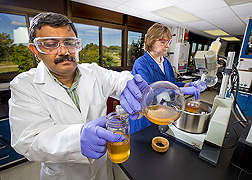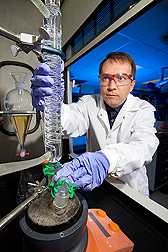In Peoria, a Brisk Business in Biodiesel Research
It’s now clear that biofuels need to play a bigger part in the U.S. fuel supply. So Agricultural Research Service scientists are continuing their search for low-cost, low-maintenance plants that can be used to produce biodiesel—and ways to use biodiesel coproducts to improve the fuel’s performance.
Sometimes candidates for biodiesel production turn up in unexpected places. For instance, field pennycress (Thlaspi arvense) has a reputation as a roadside nuisance, but like its other relatives in the Brassicaceae family—including canola, Camelina, and mustard—it puts out a prolific yield of oil-rich seeds.
At the ARS National Center for Agricultural Utilization Research (NCAUR) in Peoria, Illinois, a team in the Bio-Oils Research Unit decided to take a closer look at the resilient weed. Chemists Bryan Moser, Gerhard Knothe, and Terry Isbell and plant physiologist Steven Vaughn, in the Functional Foods Research Unit, all pitched in on the project.
“If we produce field pennycress for biodiesel, there’s no food-versus-fuel issue,” says Moser. “It can be cultivated in the winter, also helping to protect the soil from erosion. After the pennycress is harvested in the spring, the same field can be used for corn or soybean production.”
|
|
Field pennycress is compatible with existing farm infrastructure and requires minimal pesticides, fertilizers, and water, he notes.
Isbell collected wild field pennycress near Peoria and identified it as a potentially useful new crop. Moser’s team then pretreated some of the pennycress oil with acid. The scientists then reacted a type of alcohol called “methanol” with pretreated and untreated oils to produce biodiesel and glycerol from both. Pennycress oil was unusual among crude oils in that it yielded high-quality biodiesel without pretreatment.
These processes generated methyl esters—in other words, biodiesel. After some additional refining, the finished biodiesel was tested to see if it met the biodiesel fuel standard established by the American Society for Testing and Materials (ASTM). A similar standard has been developed in Europe by the Committee for Standardization (CEN). The results suggest that with some work, the problematic pennycress could become a commercial commodity.
A Cold Start
All diesel-based oils start to gel at some point as temperatures drop. So the cloud point—the temperature at which crystals become visible in the fuel—is a crucial factor in both biodiesel and petrodiesel production. Another important property is the pour point, which is the temperature at which the fuel fails to pour because it has sufficiently solidified. The average cloud and pour points for field pennycress biodiesel were -10°C and -18°C—well below the cloud and pour points of soybean oil-based biodiesel. This result suggests that field pennycress biodiesel is better suited to cold climates than most other biodiesel fuels.
Another important factor is a fuel’s cetane number, which indicates how quickly the fuel combusts once it’s injected into the combustion chamber of a diesel engine—the higher the number, the better the performance. The cetane number of field pennycress methyl esters was 59.8, which exceeded the minimum cetane number limits specified by ASTM (47) and CEN (51).
|
|
Missed It By That Much
On one measure, however, field pennycress fell short of the mark. Oxidative stability is another critically important quality of biodiesel. A higher oxidative stability is desired and means that the fuel is more stable to unwanted oxidative degradation. The oxidative stability of methyl esters generated from field pennycress oil fell below the minimum value specified in the CEN standard but exceeded the ASTM standard. This indicates that biodiesels derived from field pennycress would need antioxidant additives to meet some industry standards for commercial fuels.
In addition, field pennycress methyl esters didn’t meet the CEN standard for kinematic viscosity (a measure of thickness), but were within the range specified in the ASTM standard. Blending with less-viscous fuels could be a strategy to overcome the relatively high kinematic viscosity of field pennycress biodiesel.
Moser thinks these may be only small setbacks in the search for a new biodiesel feedstock, since essentially all biodiesel fuels require antioxidant additives, and blending is becoming more common. “We’re looking for biofuel crops that can be grown in the Midwest,” he says. “Our results show that field pennycress could well be one of those crops.”
A Coproduct Comes Full Circle
When producers generate 9 gallons of biodiesel, they also generate 1 gallon of glycerol. Making use of the glycerol on a 10-gallon scale isn’t too tough—but U.S. biodiesel production reached 700 million gallons in 2008. Even though purified glycerol can be used in cosmetics and other products, there’s currently a glut in the global glycerol market because of biodiesel production.
So chemist Shailesh Shah, formerly in the Bio-Oils Research Unit, wrestled with the question of how to use all that glycerol. He took 23 different types of vegetable oils and diluted them with glycerol derivatives to see if this could improve their pour points and cloud points.
Shah found the glycerol-based diluents had the most impact on the pour point of a type of chemically processed soybean oil called “epoxidized” soybean oil. When he added glycerol at 10 percent volume to this oil, the pour point dropped from -6.3°C to -11.7°C, a 54-percent decrease. When he added glycerol at 5 percent volume to camelina oil, the pour point dropped from -17.7°C to -20.3°C. The pour points of palm oil, mid-oleic sunflower oil, and sunflower oil also dropped significantly when diluted with glycerol derivatives.
Shah also found that the effect of glycerol derivatives on pour point could vary depending on whether the fatty-acid chain in the glycerol is a straight chain or a branched chain. Branched chains had more of an effect on the pour points of vegetable oils with higher levels of saturated fats, such as palm oil. Straight chains were more effective at lowering the pour points of vegetable oils with higher levels of unsaturated fatty acids, such as camelina oil.
“Glycerol utilization is a very important part of biodiesel research,” Shah says. “It’s a challenge for producers, but this research shows we might be able to use glycerol, which is a coproduct of biodiesel, to improve low-temperature properties of vegetable oils and, potentially, biodiesel.”—By Ann Perry, Agricultural Research Service Information Staff.
This research supports the U.S. Department of Agriculture priority of developing new sources of bioenergy and is part of Bioenergy (#213) and Quality and Utilization of Agricultural Products (#306), two ARS national programs described at www.nps.ars.usda.gov.
To reach the scientists mentioned in this story, contact Ann Perry, USDA-ARS Information Staff, 5601 Sunnyside Ave., Beltsville, MD 20705; (301) 504-1628.
"In Peoria, a Brisk Business in Biodiesel Research" was published in the November/December 2010 issue of Agricultural Research magazine.









